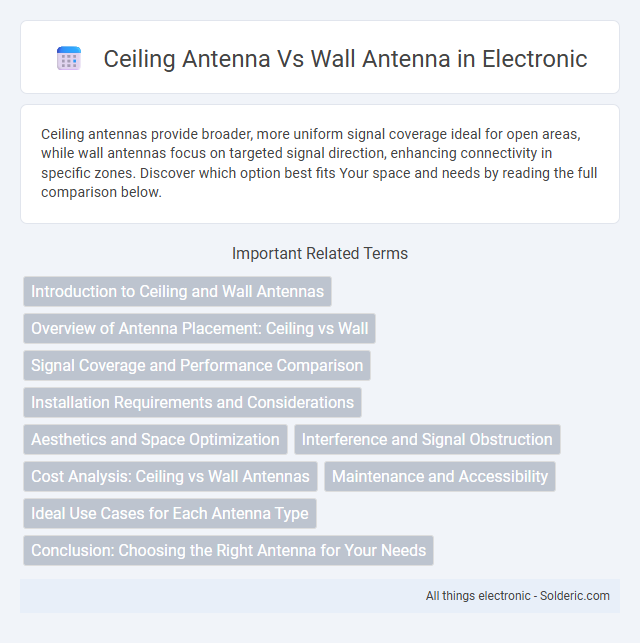Ceiling antennas provide broader, more uniform signal coverage ideal for open areas, while wall antennas focus on targeted signal direction, enhancing connectivity in specific zones. Discover which option best fits Your space and needs by reading the full comparison below.
Comparison Table
| Feature | Ceiling Antenna | Wall Antenna |
|---|---|---|
| Installation Location | Mounted on ceiling | Mounted on walls |
| Coverage Area | Wide 360deg horizontal coverage | Directional coverage, limited to one side |
| Ideal Use Case | Open spaces, large rooms | Corridors, hallways, specific zones |
| Aesthetic Impact | Less visible, blends with ceiling | More visible, mounted on vertical surfaces |
| Signal Strength | Uniform signal distribution | Focused, potentially stronger in one direction |
| Price Range | Moderate to high | Low to moderate |
| Installation Complexity | Requires ceiling access, moderate skill | Easier installation on walls |
Introduction to Ceiling and Wall Antennas
Ceiling antennas are designed to be installed on or within ceilings, providing broad, omni-directional signal coverage ideal for open indoor spaces. Wall antennas, mounted on vertical surfaces, often offer targeted signal enhancement for specific areas, making them suitable for narrow hallways or rooms with obstructions. Your choice between ceiling and wall antennas impacts signal distribution efficiency and aesthetic integration within your environment.
Overview of Antenna Placement: Ceiling vs Wall
Ceiling antennas provide omnidirectional signal coverage ideal for open spaces, enhancing Wi-Fi distribution by minimizing obstructions and interference. Wall-mounted antennas focus signal strength in specific directions, making them suitable for targeted coverage in narrower or elongated rooms. Choosing between ceiling and wall antenna placement depends on the space layout, signal propagation requirements, and desired coverage area for optimal network performance.
Signal Coverage and Performance Comparison
Ceiling antennas generally offer more uniform signal distribution in indoor environments by radiating signals downward over a wide area, making them ideal for open office spaces and large rooms. Wall antennas tend to provide stronger directional signals along corridors or confined spaces, resulting in enhanced signal strength and reduced interference in targeted zones. Performance varies based on placement and surroundings, but ceiling antennas typically excel in broad coverage while wall antennas optimize signal penetration within specific areas.
Installation Requirements and Considerations
Ceiling antennas require mounting on or above the ceiling, often necessitating access to ceiling spaces and consideration of obstructions like insulation or ductwork, making installation suitable for commercial or larger residential settings. Wall antennas are installed on vertical surfaces, offering easier access and simpler wiring but must be positioned to avoid signal interference from furniture or walls. Your choice depends on installation complexity, available mounting locations, and signal propagation needs in your environment.
Aesthetics and Space Optimization
Ceiling antennas offer a sleek, inconspicuous design that blends seamlessly into your room, maximizing aesthetics by remaining out of direct sightlines. Wall antennas, while slightly more visible, can be strategically placed to complement existing wall features and save valuable floor space. Your choice should balance aesthetic preferences with the spatial layout of your environment for optimal integration.
Interference and Signal Obstruction
Ceiling antennas typically experience less signal obstruction due to their elevated placement, allowing clearer line-of-sight communication and reduced interference from furniture or walls. Wall antennas, however, may encounter more interference caused by physical barriers such as reinforced concrete or metal studs within walls, which can degrade signal strength and quality. For optimal signal performance in environments with multiple obstructions, ceiling-mounted antennas generally provide more reliable wireless connectivity.
Cost Analysis: Ceiling vs Wall Antennas
Ceiling antennas typically cost more upfront due to installation complexity and hardware requirements compared to wall antennas, which are generally easier and cheaper to mount. Wall antennas offer straightforward placement with reduced labor fees, making them a cost-effective choice for tight budgets. Your decision should balance installation expenses with coverage needs and aesthetic preferences to optimize overall cost-efficiency.
Maintenance and Accessibility
Ceiling antennas generally require more effort for maintenance due to their installation height, often necessitating ladders or scaffolding for access. Wall antennas offer easier accessibility for routine inspections and repairs, as they are typically mounted at reachable heights. Choosing a wall antenna can reduce downtime and maintenance costs by simplifying service procedures and increasing safety for technicians.
Ideal Use Cases for Each Antenna Type
Ceiling antennas are ideal for large open indoor spaces such as offices, conference rooms, and retail stores, providing broad, even coverage and reducing dead zones by being centrally located above users. Wall antennas suit corridors, narrow rooms, or spaces where ceiling mounting is impractical, offering targeted signal boosting in elongated or partitioned areas. Selecting the appropriate antenna type depends on the layout and specific coverage requirements, ensuring optimal wireless performance tailored to the environment.
Conclusion: Choosing the Right Antenna for Your Needs
Ceiling antennas provide broader indoor coverage and are ideal for open office spaces or large rooms, while wall antennas offer targeted signal directionality, making them suitable for hallways or small areas. The choice depends on the specific environment, installation constraints, and desired signal distribution. Prioritize factors such as building layout, signal strength requirements, and ease of installation to determine the optimal antenna type for your wireless network.
ceiling antenna vs wall antenna Infographic

 solderic.com
solderic.com